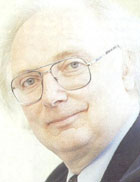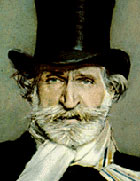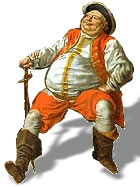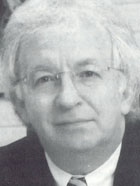2005 Spring Festival - The test pieces
5-May-20054BR looks at the three test pieces to be used this weekend in Blackpool; Philip Wilby's immense 'Masquerade', Peter Graham's electrifying 'Montage' and Edward Gregson's groundbreaking 'Connotations'.
 Grand Shield:
Grand Shield:
Test piece review: 'Masquerade' by Philip Wilby
When Philip Wilby was asked by Bram Gay to write a test piece for the 1993 British Open Championships, the idea of it being a tribute to the great Giuseppe Verdi seemed like an opportunity to good to miss. The tribute was not so much to the man himself, but rather more in homage to what was the composers last great operatic work, "Falstaff", which was written in it's final form in 1894, when the Italian with highly common name of 'Joe Green' was aged 81.
Wilby set about burrowing away at the opera so that he could mould his tribute from the colourful themes and arias it contained in abundance, whilst he readily acknowledged that he would in his words use: "some of Verdi's music, and some of Shakespeare's plot, and woven them into a fabric with highly demanding music of my own to produce a work in the great tradition of operatically based brass band pieces". He wasn't wrong. There is music aplenty (Verdi was a pretty good bloke when it came to writing a ditty), but the piece has gained a place in banding folklore as something of a "rock ‘ard" test piece rather than a great bit of musical writing.
'Masquerade' in effect represents the high water mark of technical brass band composition - a watermark that in 1993 was felt by many to be too high for the bands of the day to reach. It is without doubt the most detailed piece of brass writing that has ever been written as a contest work (the term test piece has never been so apt) and today, some 12 years later and two years after it was memorably used at the Royal Albert Hall at the National Finals, it is safe to say that there will not be too many performances at the Winter Gardens that fully conquer the technical aspects of the work.
In 1993, there was just the one - Williams Fairey giving a scorching performance that won the contest by four clear points (the biggest winning margin for 35 years) and a performance that set that great band up to win their last "Double" when they went on to triumph at the Nationals a month or so later.
A decade later there were a few more – the standard of the bands had increased enormously and the top four performances really had a stamp of class about them, with Fairey's once more coming out on top.
 There may well be a few scorchers this time around - but not many more than that as the field isn't as strong as two years ago in Kensington, and like the 1993 contest at the Free Trade Hall, a lot of debate will surely centre around whether or not the audience, and especially the judges will actually be able to hear the detail that the piece demands, as the acoustic in the Ballroom isn't the best.
There may well be a few scorchers this time around - but not many more than that as the field isn't as strong as two years ago in Kensington, and like the 1993 contest at the Free Trade Hall, a lot of debate will surely centre around whether or not the audience, and especially the judges will actually be able to hear the detail that the piece demands, as the acoustic in the Ballroom isn't the best.
The acoustics at the Free Trade Hall were never perhaps the greatest for sure, but in comparison to the Royal Albert Hall and here in Blackpool they were almost perfect.
There is a deep suspicion that bands know this too well and will forgo the opportunity of displaying their abilities to make the detail count in exchange for the chance to make "effects". Clarity and precision are likely to be exchanged for sheer sound and aural effect, and whilst you cannot blame the bands for doing this (any attempt at subtlety will surely be lost in the cavernous boom of the auditorium) you can ask yourself why was the work chosen in the first place – it is immensely difficult and perhaps too stern a test for the majority of the bands here. We may be proved wrong though.
The music itself portrays the characters found in the Shakespeare play to full effect. Falstaff is something of a loveable rogue, all beer and boasting - every public house in the land has one - he's the type who always butts into a private conversation with, "I could have done that".
There is also a darker side to him also, as an be found in some of his less salubrious features which the Bard explored in the 'Henry' plays. He is never a great Shakespearean leading character, but one who tends to "steal" the odd scene or two and the plot as such surrounds his downfall at the hands of those people he has wronged once too often.  The scene is Windsor Great Park and Falstaff, ever boastful and full of himself has been lured for what he believes is a bit of "inflagrante delicto" dressed up as Herne the Hunter with a lady of none too respectful a reputation. All those wishing to get one over the old goat also come dressed up in various disguises from hobgoblins to fairies, and so the music becomes a surreal picture of a somewhat alcohol induced party in the park. Whoever thought 18 - 30 holidays were something new eh?
The scene is Windsor Great Park and Falstaff, ever boastful and full of himself has been lured for what he believes is a bit of "inflagrante delicto" dressed up as Herne the Hunter with a lady of none too respectful a reputation. All those wishing to get one over the old goat also come dressed up in various disguises from hobgoblins to fairies, and so the music becomes a surreal picture of a somewhat alcohol induced party in the park. Whoever thought 18 - 30 holidays were something new eh?
Wilby explores the characters involved in many ways, with the three trombones representing Falstaff's companions, the solo cornet becoming the love interest (or tease as the case maybe) and the euphonium playing the fat horny old devil himself. It is very clever descriptive writing - fiendishly difficult for all concerned, whilst you get the feeling that the chattering and suppressed giggling that is illustrated by the percussion interjections signifies the voyeurs peeing themselves at how stupid everyone looks.
There is detail everywhere throughout the score - much of it at low dynamic levels, whilst the percussion adds colour (and alcohol induced hiccups in the form of the whiskey bottle in F) that drives the music on. The troms feature early and the bass trombone players will find themselves literally gasping like asthmatics after their little playful interjection after letters D and G. Bass troms nowadays have so big a bore (the instruments size, not the player themselves it must be added - although in some cases…..) that their feature will take some playing to come over clean and accurate.
The fulcrum of the piece however is to be found with the euph solo cadenza after J - and it will be here that perhaps the chance to win, or lose a place at the British Open will come. There are many fine players on show here, from as far afield as Australia and Norway but you can guarantee most of them will be shaking in their shoes and wishing they were elsewhere come this Piu Mosso.
In 1993 many euph players took something of the easy option and got a bit of help from their fellow 2nd euph to help them out - this led to the cadenza sounding disjointed and lacked any real sense of style, so it will be interesting if this occurs again.
The pinnacle moment comes towards its end with a series of four ever increasing two note groups, starting with an octave D - D, moving to a 13th, a 17th and then finally three octaves - bloody hard at any time of the day or night for sure - and as it is also marked pianissimo lento dolce, nigh on impossible for all but the very best, and bravest of players. Those who do manage it with by actually observing the markings should be bought free drinks by their band for the rest of the weekend at least!
After this comes a beautiful little interlude that will require bands to take immense risks in dynamics to make come off, with the sop players having to cope with a real bum clencher solo motif just before letter M. Do not be surprised if the overall dynamic levels are not quite as marked on your study score. If a band makes the Adagio section before O come off though it will sound magical. Triple piano, with the sop shimmering like the moon itself on a top A, this section portrays the moon rising in the night sky as Falstaff prepares to reveal himself (musically it must be said - unlike that old Labour MP on Clapham Common a few years ago).
If it works then brilliant - if not and it's safety first, it could sound more like "Shine on Harvey Moon".
Then bedlam strikes as Falstaff is caught with his trousers around his proverbial ankles and everyone has a turn of poking fun at the old fool with a series of turns, pinches and mockery. Falstaff, realising he's been done up like a kipper though takes it all on the chin (or three in his case) and bellows the famous "All the World's a Joke" line, which just like those hackneyed American sitcoms means that everyone laughs with him rather than at him and it's off for a jolly romp home hand in hand after having a splendid time without the aid of artificial stimulants of any kind.
The run for home though contains some crackingly hard writing and many a band will come a cropper in the final section from V onwards. The last six bars in particular will show how good a band really is when their lips are down to their knees. It is almost cruel. Get that out of the way and it's a big bash of an ending - although the last three notes are semi quavers and not tenuto crotchets as many will try and play as they eek out the last bit of drama from the piece.
There should be plenty of applause and the winning band will as the libretto itself says "…. he laughs best who has the last laugh!"
'Masquerade' is an amazing piece of brass band writing - perhaps a touch too amazing for the acoustics of the Albert Hall when it was last used and possibly here in Blackpool it must be said, and it will be a great pity (and a disservice to the music) if bands opt to try and blow their way through it rather than try to capture the essential wit of the writing.
The humour of Verdi's "Falstaff" is rather black and slightly disturbing - more "League of Gentlemen" than "The Fast Show" - so we can only hope the bands take their lead and try impress by using musical intelligence rather then going for a belly laugh with the old pie in the face routine. Those who do, will certainly have the last laugh.
Iwan Fox
 Senior Cup:
Senior Cup:
Test piece review: 'Montage' by Peter Graham
'Montage' was commissioned by the All England Masters Brass Band Championships to be used for their contest in 1994, which was won by the BBS Fodens Band conducted by Howard Snell.
Peter Graham had written extensively for brass bands before he wrote 'Montage', but this composition represented a major shift in his compositional outlook and sought its inspiration from the likes of Lutoslawski and Messian. It is a three-movement work that lasts around 15 minutes in duration.
The first movement intrada forms a perfect ABCBA arch. Generative thematic fragments appear in A above a pulsating timpani line which in turn is mirrored by the glockenspiel; B is characterised by glittering cornet work and figures whilst C is a sinuous duet punctuated by sharply descending semitones. It has some huge technical demands for trombone, euphonium and cornet, as well as soprano, baritone and horn. Although it may be the least difficult of the three movements in the piece, it is the one that could cause the most difficulty. The ending in particular is elegant and subdued, but still ha an underlying pulse that means that it has forward momentum. Relax too soon and it will all come to a rather dribbling halt.
The middle movement is a beautiful detached chaconne, both expressive and melodic which revolves around a chord sequence, which builds to the climax of the whole piece. The opening requires balance and sensitivity from the cornet section before the solo cornet explores the limits of their lyrical playing ability with a sublime extended solo. It is later joined by an equally expressive euphonium in a duet of complex yet thoughtful writing. Smaller interjections from horn and soprano lead once more to the reiteration of the main thematic material before a lovely subdued ending in which the cornet soloist once more must reveal an understanding of line and musical shape right to the very end.
The final Rondo is full of drive and verve and moves towards a powerful conclusion, direct from the opening soprano and bass feature towards to very ending, which makes immense demands on player's stamina and technique.
It opens with the now infamous soprano and Eb tuba jumping duet before it evolves into complex rhythmic patterns which gave a foundation to a soaring main tune. These elements are further developed as we head on with an immensely difficult section of writing involving shock notes from the trombones, followed by interjections from the xylophone and cornets which build to the start of a ground bass theme and the run for home.
This builds once more to a huge climax and a return to the monothematic material explored in the opening movement. The composer has noted that it explores in musical terms the flight of an arrow in the sky before it then ultimately returns to earth – the final bars in particular should be played without recourse to over exaggerated rallentando.
Iwan Fox
 Senior Trophy:
Senior Trophy:
Test piece review: 'Connotations' by Edward Gregson
There is little doubt that Edward Gregson's ‘Connotations' was a ground breaking work for brass band when it was written for the 1977 National Brass Band Championships of Great Britain, held at the Royal Albert Hall, and which was won by the Black Dyke Band conducted by Major Peter Parkes.
Originally it was to be called ‘Variations in a Fourth' – a homage to its inspirational source, Gilbert Vinter, and like many of Vinters' works its scope of thought, musical language and intuitive use of rhythm was light years away from the works that had been recently used in the early to mid 1970's at the contest – such as ‘Freedom', ‘Fantasy for Brass Band', ‘Un Vie De Matelot', and ‘Sinfonietta – The Wayfarer', all of which seemed immediately outdated by the time the contest on the 8th October 1977 was over.
The importance of the work (and that it must be said of Elgar Howarth's ‘Fireworks', which was used at the British Open in 1975) cannot be underestimated, as without its acceptance the movement would never had allowed itself to progress to the likes of Philip Sparke, Philip Wilby and the like.
The use of extensive percussion as an integral part of the piece, rather than just to add the odd effect, was of course a major move forward and allowed the composer to explore more adventurous musical colours.
In writing an appraisal of the work prior to its use at the National Finals, the great Eric Bravington wrote in the British Bandsman newspaper that: "Whilst I have approved of the introduction of percussion in brass band works of recent years, I feel that the composer may have set the bands many problems in this section."
How wrong he was, and he further compounded his belief (and that of many at the time with their conservative outlook on brass band repertoire) when he added: "With the amount of equipment required, I also feel that it may limit the possibility of ‘Connotations' becoming a repertoire work for future brass bands programmes. Perhaps the composer might be encouraged to re-score this effective section's work with this in mind."
What would their like think of today's huge works from Wilby and company then?
In addition, the construction of the piece (the first variation precedes the main theme) was also something new and bold and allowed Gregson to give a vibrant immediacy to the work right from the word go.
The work is based around a series of linked and inter related variations (9 in all) on the original theme which is heard after Variation 1, which forms the introduction, takes place. Each variation has its own characteristic, and each explores different facets of modern brass technique and musicality. There is even a section that in many ways pays homage to the old – Variation 6 is a section of cadenzas for cornet, horn and euphonium, but overall it is a modern context that explores new territory for brass band.
Variation 1 forms the introduction to the piece, and this is then followed by the main theme – a broad and sonorous chorale. Variation 2 is a lively sequence of repeated semi quaver passages passed around the band, whilst in Variation 3 these ideas are extended into an accompanying figure with muted effects from the cornet section.
Variation 4, the longest variation, is a slow and lyrical section of elegance, whilst Variation 5 explores complex rhythmic patterns in 7/8 time. Variation 6 contains the famous cadenzas – the cornet in particular extended fully, before Variation 7 is a lively and witty scherzando.
This leads into Variation 8, which is in Fugue structure – first announced by the horns, and then led by other instruments, before it leads to the reinstatement of the original theme I quite majestic fashion in the final Variation 9. It ends with a Coda, which reprises the original first variation before a huge climatic end brings the work to a close.
Iwan Fox















